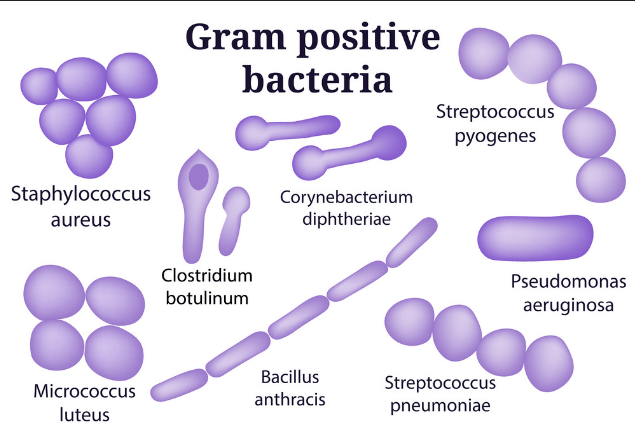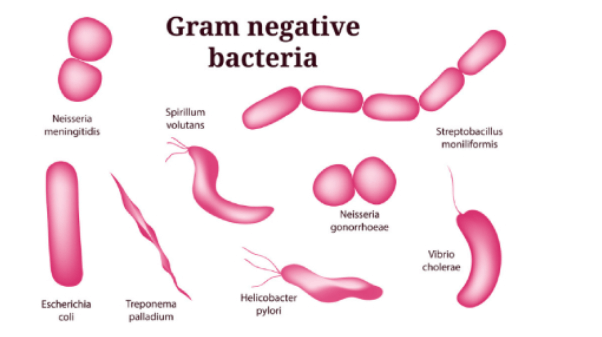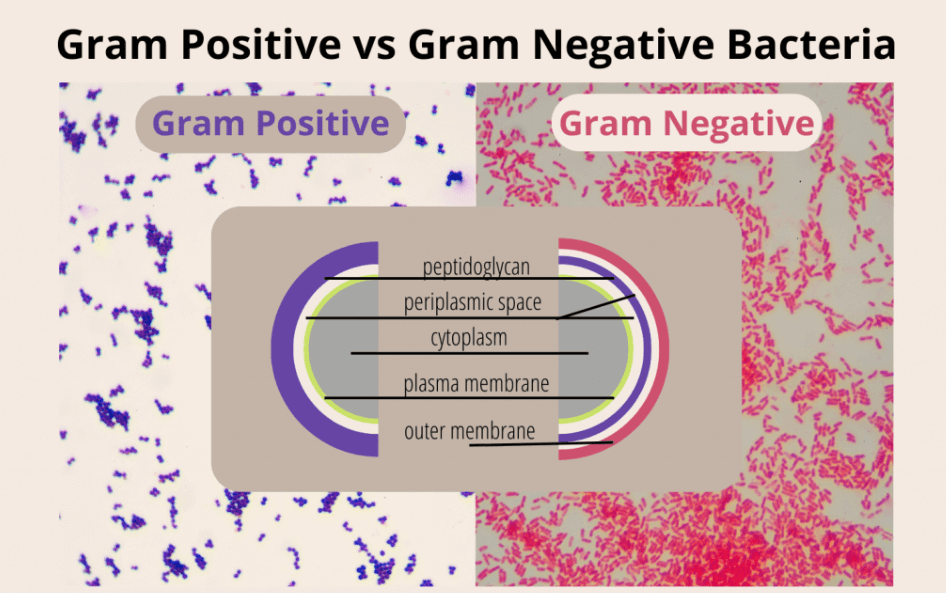Table of Contents
Bacteria are tiny living things, too small to see with our eyes. They come in different types, like Gram-positive and Gram-negative. The main difference between them is the way their cell walls are built. Gram-positive bacteria have thick cell walls, which makes them turn purple when a special stain is added. Gram-negative bacteria have thinner cell walls and turn pink instead. Both types can be found almost everywhere, including inside our bodies. For more information regarding the Difference Between Gram-Positive and Gram-Negative Bacteria go through the complete article below.
What are Gram-positive Bacteria?
Gram-positive bacteria are a type of bacteria that have a thick outer cell wall made of a substance called peptidoglycan. This thick wall gives them their name because they turn purple when stained in a lab test called the Gram stain. The thick wall helps protect the bacteria and gives them shape.

Some common Gram-positive bacteria include Staphylococcus and Streptococcus, which can cause infections like strep throat. However, not all Gram-positive bacteria are harmful; some are actually beneficial and are used in making foods like yogurt. These bacteria are different from Gram-negative bacteria, which have a thinner cell wall and don’t stain purple.
What are Gram-negative Bacteria?
Gram-negative bacteria are another type of bacteria that have a thin cell wall surrounded by an outer membrane. This structure is different from Gram-positive bacteria, which have a thick cell wall. When tested with a Gram stain in the lab, Gram-negative bacteria do not turn purple; instead, they turn pink.

The outer membrane of these bacteria can make them more resistant to antibiotics, which can make infections harder to treat. Some Gram-negative bacteria can cause diseases like food poisoning and pneumonia. Examples include Escherichia coli (E. coli) and Salmonella. However, like all bacteria, not all Gram-negative types are harmful; some play important roles in the environment and our bodies.
Difference Between Gram-Positive and Gram-Negative Bacteria
This table summarizes the main differences Between Gram-Positive and Gram-Negative Bacteria based on cell wall structure, staining properties, and other biological characteristics. These differences help scientists figure out which bacteria they are dealing with and how to treat infections caused by them.

| Difference Between Gram-Positive and Gram-Negative Bacteria | ||
| Characteristics | Gram-Positive Bacteria | Gram-Negative Bacteria |
| Cell Wall | Thick (20-80 nm) | Thin (7-8 nm) |
| Peptidoglycan Layer | Multiple layers, make up 70-90% of the cell wall | Single or few layers, make up 10-20% of the cell wall |
| Outer Membrane | Absent | Present |
| Teichoid Acids | Present in the cell wall | Absent |
| Periplasmic Space | Usually absent or very small | Present between the inner and outer membranes |
| Staining | Retains crystal violet stain, appears purple | Does not retain crystal violet, and appears pink/red |
| Lipid Content | Low (1-4%) | High (11-22%) |
| Susceptibility to Penicillin | More susceptible due to lack of outer membrane | Less susceptible due to protective outer membrane |
| Endotoxins | Absent | Present (lipopolysaccharides in the outer membrane) |
| Examples | Staphylococcus aureus, Bacillus species | Escherichia coli, Salmonella species |
Different Features of Gram-Positive Bacteria
Gram-positive bacteria have several distinct features that differentiate them from gram-negative bacteria. These features are crucial in the identification and treatment of infections caused by gram-positive bacteria.
- Thick Peptidoglycan Layer: The most notable feature is their thick peptidoglycan layer, which is much thicker than that in gram-negative bacteria. This layer gives the cell wall rigidity and helps the bacteria maintain their shape.
- Absence of Outer Membrane: Unlike gram-negative bacteria, gram-positive bacteria lack an outer membrane. This makes them more susceptible to certain antibiotics that target the cell wall.
- Resistance to Physical Disruption: The thick cell wall gives gram-positive bacteria a higher resistance to physical disruption compared to gram-negative bacteria.
- Endospore Formation: Some gram-positive bacteria, such as Bacillus and Clostridium species, can form endospores, which are highly resistant to environmental stress.
- Exotoxin Production: Many gram-positive bacteria produce exotoxins, which are potent toxins released into the surrounding environment, contributing to disease symptoms.
- Lack of Lipopolysaccharides (LPS): Gram-positive bacteria do not have LPS in their cell wall, which is a characteristic feature of gram-negative bacteria. This makes them less likely to trigger a strong immune response related to LPS.
Features of Gram-Negative Bacteria
Gram-negative bacteria are a large and diverse group of bacteria with distinctive features that differentiate them from gram-positive bacteria. Here are some of the most common characteristics:
- Cell Wall Structure:
- Thin Peptidoglycan Layer: Gram-negative bacteria have a thin layer of peptidoglycan, which is located between the inner and outer membranes. This contrasts with the thick peptidoglycan layer found in gram-positive bacteria.
- Outer Membrane: They have an additional outer membrane composed of lipopolysaccharides (LPS), phospholipids, and proteins. The outer membrane provides an extra barrier against certain antibiotics, making gram-negative bacteria more resistant to some treatments.
- Lipopolysaccharides (LPS):
- The outer membrane contains LPS, which is also known as endotoxin. LPS is important for the structural integrity of the bacteria and can trigger strong immune responses in humans and animals.
- Porins:
- The outer membrane of gram-negative bacteria contains porins, which are proteins that form channels allowing the passage of small molecules, like nutrients and ions, into the cell.
- Periplasmic Space:
- Between the outer membrane and the inner cytoplasmic membrane, there is a space known as the periplasmic space. This space contains various enzymes and proteins that are involved in nutrient processing and defense mechanisms.
- Resistance to Antibiotics:
- Due to their outer membrane and the presence of efflux pumps (which expel toxic substances from the cell), gram-negative bacteria are often more resistant to antibiotics than gram-positive bacteria.
- Shape and Mobility:
- Gram-negative bacteria exhibit a wide range of shapes, including rods (bacilli), spheres (cocci), and spirals. Many of them are motile, possessing flagella that allow them to move.







 50 Vegetables Name for Kids in English a...
50 Vegetables Name for Kids in English a...
 Body Parts Name, All 50 Body Parts Name ...
Body Parts Name, All 50 Body Parts Name ...
 Flowers Names in English and Hindi, List...
Flowers Names in English and Hindi, List...